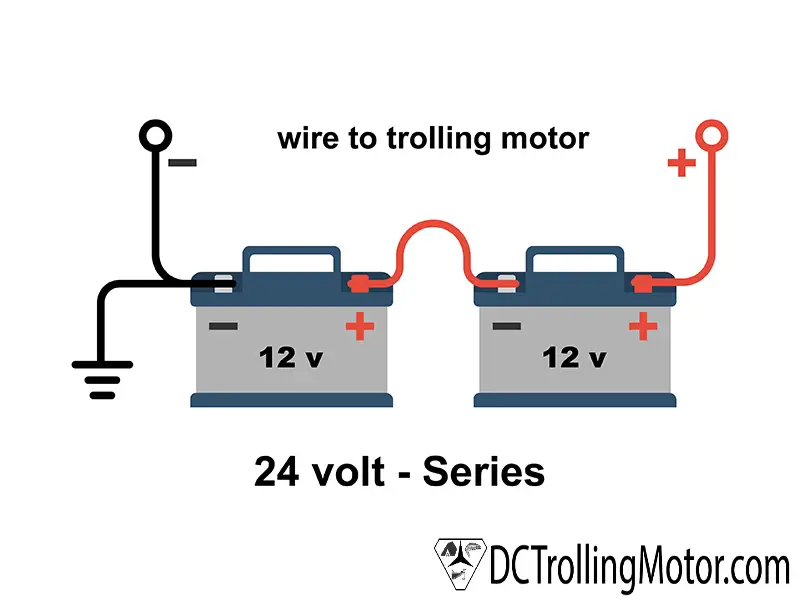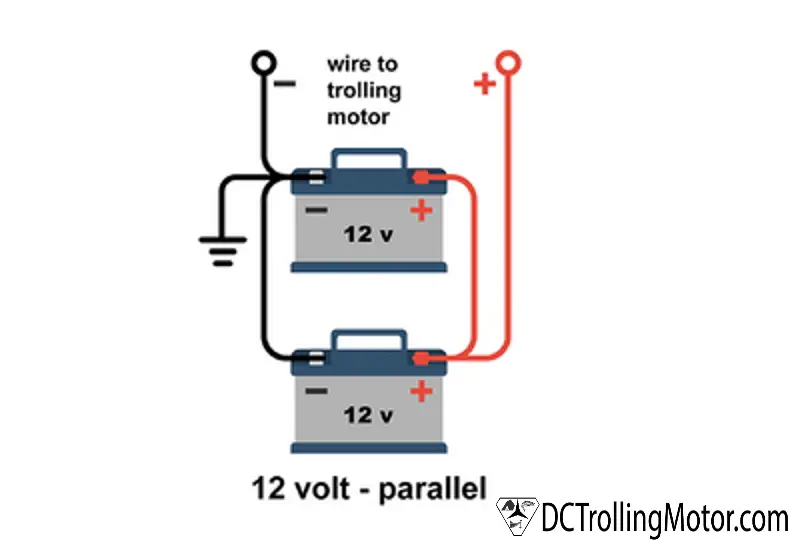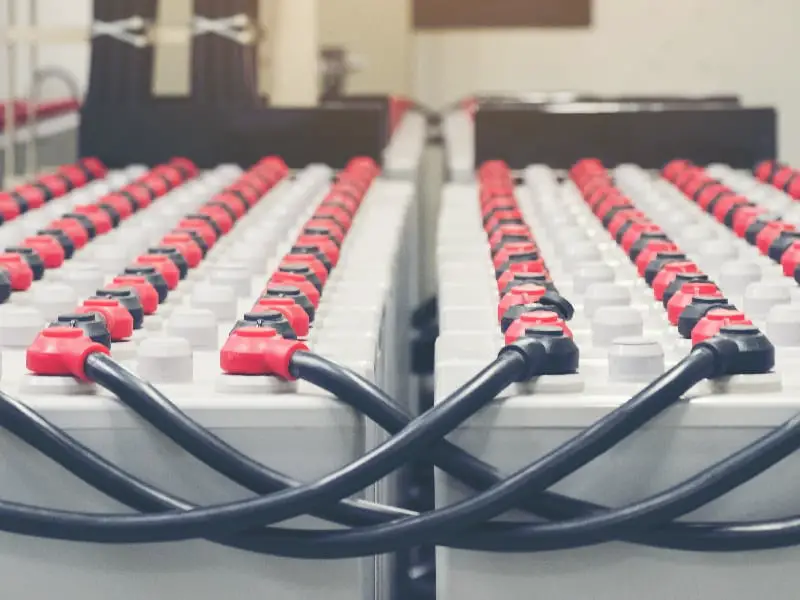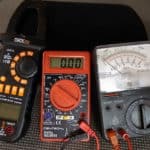Many accessories on a boat are powered by a battery, but they don’t operate on a 12-volt power source alone. For instance, larger trolling motors require either 24 or 36 volts. However, batteries with these voltages are difficult to procure. As a result, one has to connect multiple batteries in series to increase voltage where the amp hours remain the same.
To engage in such processes, you need to procure identical batteries. Avoid using old batteries with new batteries while connecting in parallel or series.
To begin with, you have to make sure that your calculations are correct; you don’t want a 12-volt trolling motor to be fed with 36 volts. After you are fully confident that you have a 36-volt motor, you must have the required room in the battery compartment that caters to three batteries.
Moreover, it is required by coast guard regulations that you have either a mounting bracket or secured boxes for these batteries. After all, no one is going to like the prospect of their power source being disconnected or worse, shorting out.
Before moving further, you should have an idea about a battery bank. When two or more batteries are joined together for a single application such as for an electric trolling motor, the integrated solution is known as a battery bank. The purpose of this connection is to increase voltage or amperage or both.
Hence, whenever you require greater power for your boat, instead of going for a larger and more expensive battery, you can learn the art of making battery banks.
Note: most links in this article are Amazon.com Affiliate links, see Affiliate Disclosure, thank you.
Difference between Series and Parallel Battery Wiring
To make sure you operate your trolling motor properly, you should know how to configure your battery in series or parallel. Ultimately, it depends on whether you need more voltage or amperage.
Series Battery Wiring
To increase voltage, you should connect batteries in series while maintaining the same amperage rating (known popularly as amp hours). For instance, you can join two 12-volt batteries in series to create 24 volts, but the overall amp-hours remain the same.
You need a jumper wire to connect batteries in a series. Take the negative terminal and the positive terminal of the first and second batteries respectively and connect them via a jumper wire. Now, link the negative and positive terminals via another cable set to your application.

When connecting the batteries, don’t cross the other open terminals with each. This can cause a short-circuit, inflicting damage and injury to those present at the scene. Ensure that the connected batteries are identical, having the same capacity and voltage rating. Or else, you may run into charging issues or reduce your battery life permanently.
Parallel Battery Wiring
Parallel battering wiring maintains the same voltage, but it increases the current rating. This means that your amps can be doubled, but your volts remain 12. However, bear in mind that as the amperage is raised, you might require a more powerful cable to ensure that it can withstand the heightened current.
Click here to read our article on the Best gauge wire for a 24 volt trolling motor?

While joining batteries in parallel, you require two jumper wires. The first one connects both negative terminals of batteries while the other joins the positive terminals with each other. Then, choose any of the batteries and connect your load to it where it will draw evenly.
To make sure that the batteries are kept equalized, you can connect the load to the negative terminal at one end of the battery pack and the negative terminal to the other end of the battery pack.
How to Select the Right Battery?
When it comes to picking up the right batteries for your trolling motor, you have to consider two considerations. These are listed below.
Type of Battery
According to experts, there are two types of deep-cycle 12-volt batteries commonly used for trolling motors: AGM and Lead Acid Wet-Cell Batteries. With deep-cycle batteries, you can discharge low amperes of current for a long time and avail more recharging cycles.
- AGM batteries – AGM stands for Absorbed Glass Mat. These are known for lasting longer after a charge and come with a better life-span. These batteries are entirely sealed. An AGM battery can last for four years, whereas a conventional deep cycle battery lasts only two years at max. Additionally, AGM batteries are also extremely durable and vibration resistant. However, AGM is also a costlier option and you may have to pay double when it comes to expenses. Hence, it is not recommended for those who have a limited budget. On the other hand, if you need premium performance and longevity, then it is your best bet. Additionally, it does not require any maintenance.
- Lead Acid Wet-Cell – They can manage the frequent recharging and draining that is standard with the use of trolling motor. Furthermore, they don’t cost much; you can purchase them for less than other battery types. However, they don’t last much – expect anywhere between one to two years. Similarly, they are prone to spillage and vibration damage, so you will have to perform a lot of maintenance with these batteries.
We didn’t consider Gel or lithium batteries as a reasonable option because of cost. However, if money is no limit then both types are great high-end options and will require special battery chargers.
Check out our complete article on What type of battery should I use for my electric trolling motor?
Amperage Rating
The amperage hour rating of a battery is not unlike the size of your car’s gas tank. A battery with a higher amperage rating will last longer. This means if you have two batteries with 100 and 115 amp hours respectively, the latter is going to last long.
Technically, for a trolling motor, a 100 amp hour battery can offer 100 amp-hours. This means that if you run a trolling at low speed and pull 4 amps, it can operate for around 25 hours. On a similar note, if you run your motor at a higher speed and pull 25 amps, it can last 4 hours.
Trolling motors perform best with large amp-hour batteries of 100AH or more.
Click here to read our article on How do I choose the proper size batteries for my electric trolling motor?
What Equipment Do You Need?
The configuration of wiring batteries with a trolling motor is a relatively easy procedure. However, to begin with, you must have the right equipment.
- Trolling motor and control (remote control, foot pedal, or hand tiller)
- Power leads
- Batteries – according to your requirement, you may need one or three 12-volt batteries.VMAX MR137-120ah AGM Sealed Marine Battery 12V(best value)
- Terminal ends – These are required to fix the motor power leads with your battery
- Jumper wire – if your requirements exceed 12 volts, then you require a wire of short lengths to connect your batteries. However, the same gauge of wire must be purchased for the entire setup.
- Circuit Breaker – It is used as a protection measure for your trolling motor.
- Trolling Motor Plug – It facilitates a speedy disconnection from the trolling motor wiring
- Quick Release Plate – It helps to remove trolling motor easily.
- Extension Wiring – Since a trolling motor has power leads with 3-5 feet, in some cases, there is a need for a greater length for wire so they can come in contact with the batteries. You have to measure the distance from batteries to the mounting location of the trolling motors. After you are done with the measurements, you will need to evaluate what is the right gauge of wire.
Click here to check out our article Best Trolling Motor Wire Extension Kits
How to Wire Batteries with a Trolling Motor?
Typically, a battery system in a boat can be split up into two components: a trolling motor battery system and the main battery system(or house battery). The 12-volt starter battery provides the outboard motor with cranking power. It is commonly used in onboard electronics, like in-depth finders. The battery system of a trolling motor can contain single, double, or triple 12-volt batteries. A jumper wire is used to connect these batteries in a series.
Note: Don’t use the batteries that are used to power the trolling motor for other accessories.
To wire the starter battery, you have to take the red wires (made of lead) from the outboard motor and connect them to the positive terminal of the battery. Now, connect the black lead wires to the negative terminal of the battery. Keep in mind that black goes to black and red goes to red. Any other electronics should be linked with the starter battery via a similar configuration.
Here is a brief guide on how you can create a trolling motor battery system. It is divided into the four most voltage systems used with trolling motors. Manufacturers advise all connections to use a 6-gauge wire. Make sure that you incorporate a 50-amp manual-reset circuit breaker in the leads of the trolling motor, no more than 7” from the batteries.
Note: Before you connect your battery systems turn off all the switches to the OFF position.
12-Volt Motors
In this configuration, you need only a single 12-volt battery.
- Link the red wire from the power cable of the trolling motor to the positive terminal of the battery. Employ a 50-amp circuit breaker with this connection.
- Connect the black wire from the power cable of the trolling motor to the negative terminal of the battery.
24-Volt Motors
Get a pair of 12-volt deep-cycle marine batteries with the following configuration. Label them as batteries A and B respectively.
- Connect the black wire from the power cable of the trolling motor with the negative terminal of the battery B.
- Connect another (red) wire from the power cable of the trolling motor to the other battery’s positive terminal. For this connection, add a 40-amp circuit breaker to the mix.
- Connect a jumper wire to the negative terminal of battery A and the positive terminal of the battery B. Make sure that the jumper wire has the same gauge as the motor leads.
We recommend Connect-Ease 24V Trolling Motor Connection kits for 24 volt systems.
12-/24-Volt Motors
Again, get a pair of 12-volt deep-cycle marine batteries with the following configuration. Label them as batteries A and B respectively.
- Connect the red wire from the power cable of the trolling motor to the battery A’s positive terminal. For this connection, you need a 40-amp circuit breaker.
- Now connect the negative terminal of the battery B with a black wire from the power cable of the trolling motor.
- Connect the positive terminal of battery B with the white wire from the power cable of the trolling motor, making up your 12-volt lead. For this connection, you need a 40-amp breaker.
- Connect a jumper wire from the positive terminal of the battery B to the negative terminal of battery A.
36-Volt Motors
This time, you have to use three 12-volt deep-cycle marine batteries and apply the following configuration.
- Connect the red wire from the power cable o the trolling motor with battery A’s positive terminal. For motors with 81 lbs, you will need a 50-amp circuit breaker. If you have motors with more than 81+ labs thrust, you require a 50-amp breaker.
- Connect the black wire from the power cable of the trolling motor with the battery C’s negative terminal.
- Connect a jumper wire from the positive terminal of battery C to the negative terminal of battery B.
Note: double-check your owner’s manual for
wire and breaker size. We have summarized
manufactures information in our articles for
your convenience. (breakers),(wire size)
Final Thoughts
These tips will ensure that you can wire the battery configuration of your trolling motors with the utmost ease. In case you require any help, you can send us a message. We live the boating life and are passionate about electric trolling motors. So, we will invest all our energy into helping you resolve any issues.
FAQ:
Q: Can I use my trolling motor with a solar panel?
A: With just two battery connections and one solar panel, it is possible to operate your trolling motor system from solar energy. For best results, add as many solar panels as needed to get enough power for your trolling motor. Check out our guide on solar panels for more info about this topic.
Q: Can I use solar panels to charge up my trolling motor batteries?
A: You can use solar panels to charge your trolling motor batteries but it can take up to a few days or more to get your batteries fully charged. That is why it is better to use solar panels to charge your battery bank with energy and then use those batteries to charge your trolling motor batteries. Check out our guide on solar panels for more info about this topic.
Tip: Your solar system should have double the amp hours of your boat system for best results.
Q: Why can’t I use the same battery configuration on my 12v and 24v trolling motors?
A: You cannot use the same battery configuration on 12V trolling motors as you can with 24V trolling motors because of the voltage difference. For example, if you try to connect a 12V trolling motor with two batteries, it would get damaged. That is why we recommend taking a volt reading before making final connections to your trolling motor.
Q: What size wires do I need for my 12v or 24v trolling motors?
A: The wire gauge size depends on the maximum amp draw of your motor and the overall length of your wires. Please, check out our guide on Sizing Wires for Trolling Motors to get a clearer picture of this matter.
What size wire is needed for a 36 volt trolling motor?
Most 36 volt trolling motor systems require 8 Gauge wire for systems up to 25 feet or 6 Gauge for longer. You can verify this information in your motor’s user manual before installation. MinnKota 36 volt Terrova 112 lb thrust motors have a clear table to verify the wire size for all engines. This MinnKota motor is rated for a maximum draw of 52 amps but will likely run much lower during normal operation. When in dought feel free to upsize your wire. It can only hurt your wallet but will add peace of mind.
How do you hook up two batteries for a 24 volt trolling motor?
The way to hook up two 12 volt batteries for a 24 volt trolling motor is a series connection. First, place your two batteries in their storage compartment if possible, with the terminals as far apart as possible. Next, use a jumper wire to go from the negative terminal of battery one to the positive terminal of battery two; some people like to fuse this wire. Then connect the trolling motor wire to the positive terminal of battery one; always use a fuse or breaker on this connection. Finally, connect the trolling motor negative wire to battery two.



